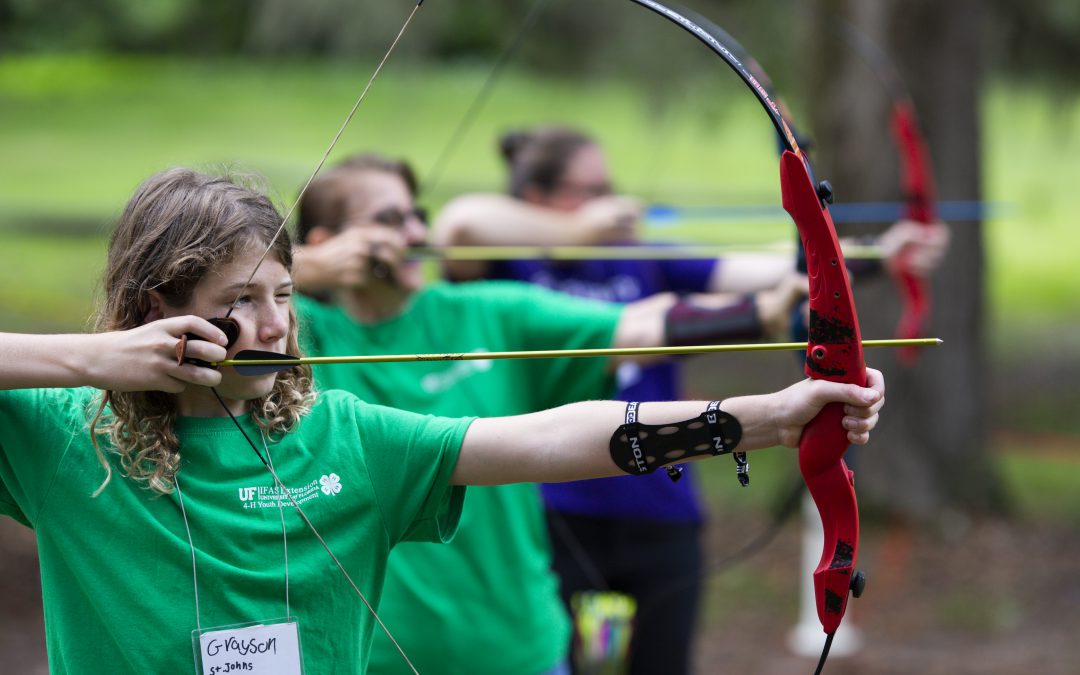
by aschortinghouse | Oct 12, 2022
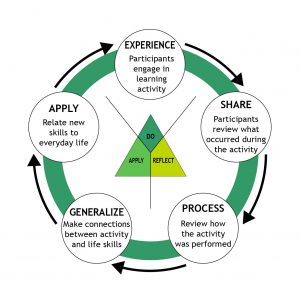
Figure One. The Experiential Learning Model. (Experiential Learning Model, 2022)
“Hands-on,” and “learn by doing” are terms you often hear in 4-H and they both refer to the Experiential Learning Model, which is the instructional strategy we use in 4-H programs. The hands-on experiences that 4-H is known for offer youth the chance to engage all their senses in the learning process. One of the prevalent models guiding hands-on experience design is the experiential learning model (Experiential Learning Model, 2022). Figure one illustrates this model, highlighting the three notable stages of doing, reflecting, and applying which serve as the core of the model. While the hands-on experience is critical, it is also important to remember that reflection and a focus on how to apply what was learned are also necessary for a compelling experience to result in impactful learning outcomes.
Designing for Experiential Learning
When designing programs, it is important to keep in mind that leaders must intentionally foster experiential learning through the careful planning and execution of programs. Three tips to keep in mind are:
- Build in Time – While this may seem obvious, it is important to keep in mind that time needs to be built into the program to allow for a thorough exploration of an experience, the reflection, and the application phases. The amount of time needed will likely vary with the experience and how many youth are involved. While the experience generally takes up the most time, be sure to reserve time for reflection activities. It is through the intentional carving out of time that it is possible to foster the whole of the experiential learning process. Ten to fifteen minutes for a reflection activity should be sufficient.
- Identify a Leader – Identify an individual to take point with each section or activity that is planned. This will help relieve some of the pressure and will allow for focused efforts on each section. When considering the reflection stage, it is important to identify an individual who will be able to facilitate the process in a meaningful way. Specifically, someone who will be able to ask unassuming questions and will be able to respond to the information shared, and relate it to the experience and application stages.
- Mix it Up – Utilize a variety of different activities to facilitate sharing and reflection. Reflection activities may be anything from using a thumb ball with specific questions passed around to free-form conversation as participants feel comfortable in contributing.
Learn More
Experiential learning is easier with practice, but we have several resources to help!
- Florida 4-H Experiential Learning Cards are a handy reference tool that include questions you can ask youth for each step of “do-reflect-apply” to help them process the activity. Once you have done this a few times, it will come naturally and you won’t need to refer to the cards, but these are helpful if you are new to this teaching strategy.
- Participate in a workshop! Both online and in-person workshops are available for volunteers who want to learn more!
-
- California 4-H has developed an excellent website with tip sheets, resources, and even an online module to learn and practice experiential learning. They have a toolbox to support volunteers and 4-H professionals- it is all free and you don’t have to register to use the tools!
- During our Northwest 4-H Volunteer Forum, January 20-21, we will have a guest speaker who will lead us all in a workshop on experiential learning! If you would like to attend, registration opens in 4Honline on October 15th.
Norman & Jordan, 2019)
Learn More
The experiential learning process is broad and well-covered in studies and educational design. If you are interested in learning more, check out the resources referenced in the article below.
by Heather Kent | Sep 21, 2022
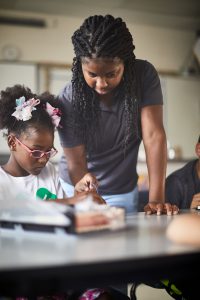
Photo By National 4-H Council
Positive youth development is an intentional process that promotes positive outcomes for youth by providing opportunities that build on young people’s strengths and fostering positive relationships with peers and caring adults (Youth.Gov, 2020). 4-H uses many different strategies to promote the healthy development of youth; but how do we know if positive youth development is really happening in our clubs and programs? One way to be confident that your club is nurturing opportunities for positive youth development is to look for signs that positive youth development is taking place. In the business and education realms, this is known as “continuous improvement.” Continuous improvement is using information (such as data, observation, or self-reflection) to improve the efficiency and effectiveness of an educational program or initiative (Clark et al., 2013). 4-H has been doing continuous improvement from the very start, when the 4-H Motto “make the best better” was adopted in 1920 (4-H History Preservation Program, 2010). Evaluating the 4-H program is a shared responsibility between faculty and staff and volunteers and helps us demonstrate the 4-H Motto to our members. While the evaluation of the total 4-H program tends to be more formal, volunteers can use feedback, self-reflection, and quality standards to continuously improve the programs so that youth can have the optimum positive youth development experience. This blog post offers three solid strategies to help 4-H professionals, volunteers, parents, and youth leaders continuously improve the 4-H groups or clubs they work with.
Feedback helps 4-H staff and volunteers close the gap between our current performance and desired performance (Pearson, 2016). Our desired performance is that 4-H experiences provide opportunities for youth to thrive while exploring their sparks in a safe environment, guided by a caring adult. Feedback should be relatively simple. You can solicit feedback from youth, parents or even other volunteers. One simple way to get feedback from younger youth is to have them complete the Clover Feedback Form. Youth can write or draw a picture about what they learned, what they would like to learn, what they enjoy about 4-H (how it makes them feel), and what they would change if they could.
Self-reflection is like feedback, but instead of asking others to describe what is (and isn’t) taking place 4-H staff and volunteers reflect on what worked well and what could be enhanced to encourage positive youth development in their club or program. Self-reflection can help 4-H professionals and volunteers reflect on what is working well and what can be improved. Some questions you might ask yourself include (adapted from Thiran, 2018):
- Is my reason for being a 4-H volunteer/youth leader the same now as it was when I started?
- Do I make myself accessible to my members, parents, and other volunteers?
- Do I seek input or feedback from my members and parents?
- If I were a 4-H member, how might I rate myself?
- Is my club/program vibrant? If not, why not?
The 4-H Quality Checklist is a simple tool to see if elements of positive youth development are taking place in your club or program. The checklist can help identify areas where your club is strong, as well as areas for improvement.
Taking time to check in with yourself, your members, and your parents can provide opportunities to apply our motto “Make the Best Better.” Leaders and 4-H professionals should set aside time at least annually to evaluate where the club or program is, and whether it is providing opportunities for youth to experience positive youth development. After spending some time thinking about continuous improvement for your club or program, discuss your findings with your local 4-H professional.
References:
- Clark, S., Hironaka, S., Carver, P., & Nordstrom, L. (2013). Continuous improvement in education [white paper]. Carnegie Foundation for the Advancement of Teaching. https://www.carnegiefoundation.org/wp-content/uploads/2014/09/carnegie-foundation_continuous-improvement_2013.05.pdf.
- 4-H History Preservation Program. (2010). 4-H Motto, Creed, and Pledge. https://4-hhistorypreservation.com/History/M-C-P/.
- Pearson. (2016). Providing Educational Feedback [white paper]. Higher Education Services. https://www.pearson.com/content/dam/one-dot-com/one-dot-com/us/en/pearson-ed/downloads/Feedback.pdf.
- Thiran, R. (2018). 5 Self-Reflection Questions Leaders Should Ask Themselves. Leaderonomics.com. https://www.leaderonomics.com/articles/leadership/5-self-reflection-questions.
- Youth.Gov. (2021, March 10). Positive youth development. Youth.Gov. https://youth.gov/youth-topics/positive-youth-development.
by Rachel Pienta | Sep 12, 2022
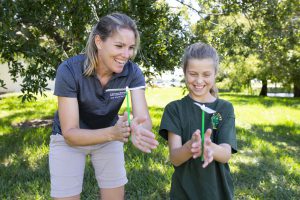
.
What is Subject Matter Expertise?
Subject matter expertise refers to the “technical knowledge and skills possessed to perform tasks related to a specific field(s)” (Harder, 2019). While county 4-H professionals (also known as agents) often bring subject matter expertise in one or more areas to the job, the subject matter expertise of program volunteers helps to expand the availability of potential program offerings. As an organization, 4-H strives to provide opportunities for learning evidence-based content (subject matter) and apply age-appropriate positive youth development (PYD) strategies to facilitate experiential learning via a collaborative youth-adult partnership.
What is a Subject Matter Expert?
Subject Matter Experts (SMEs) “are professionals who have advanced knowledge in a specific field” (Indeed, 2020). Generally, an SME will have “a deep understanding of a particular job, process, department, function, technology, machine, material or type of equipment” (Reh, 2020). In the workplace, being known as an SME is part of a career trajectory and this role or status is often based on a combination of education or training and experience. In the 4-H setting, it is possible that a subject matter expert has gained expertise through informal learning and hands-on experience. The 4-H subject matter expert may not always work professionally in the area of expertise that they bring to 4-H. For example, a skilled volunteer may work as a nurse in their professional career but leads a 4-H sewing club where she can share a deep knowledge subject knowledge and extensive skills gained through years of practice and self-guided study.
Why is Subject Matter Expertise Important to 4-H?
In 4-H, adult staff members and community volunteers work as partners with youth members to help youth “learn by doing.” The 4-H learning experience is based on the idea that “learning is an integrated process where the learner, the educator, the physical space, and culture all are changed by each other” (NIFA, 2016). 4-H clubs provide youth with opportunities to learn subject matter and develop life skills (Knowles and Diem, 2018).
While adults and youth may learn a new skill or acquire new knowledge together in a discovery process, the most common 4-H experience involves working with a subject matter expert who will help to facilitate experiential learning. 4-H learning is intended to be a “dynamic experience in a shifting learning ecosystem” (NIFA, 2016). Together, 4-H staff and community volunteers work together to bring new research and best practices into the learning experience.
How Do We Find Subject Matter Experts?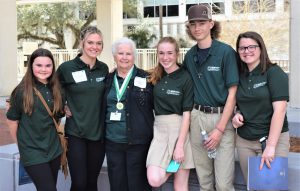
One way that 4-H can provide specialized subject matter content is through partnerships. For example, 4-H has been successful in partnering with industry professionals and university faculty to implement a variety of STEM programs. A multiyear partnership with NASA has provided many opportunities for youth to explore the world of aerospace science. However, it is not necessary to be a rocket scientist to have subject matter expertise that can be helpful to a 4-H program.
In 4-H, agents have several options available to help develop volunteer subject matter expertise. Agents may look for potential volunteers with specific subject matter expertise to match youth interests. Another option is to engage a caring adult volunteer with a desire to learn an unfamiliar skill or acquire a new knowledge set. For example, a 4-H agent with youth members who want to have a beekeeping club may find a local beekeeper to be a club leader. Another way to match a volunteer with a potential beekeeping club would be to find the adult and arrange for them to attend an Extension education program on beekeeping. Finally, it is also possible to have a volunteer with positive youth development skills that can lead a club and invite guest speakers with expertise to provide subject matter content.
Over time, youth may also become subject matter experts. For example, youth members in Wakulla participated in a poultry science club as Cloverbud and Junior members. After several years of completing projects and participating in competitions, these youth have gained considerable subject matter expertise and have started to teach content and skills to other youth at annual workshops.
Volunteers who want to increase their subject matter knowledge and expertise will find a wealth of resources within 4-H and the larger world of Cooperative Extension. Varied modes of learning are possible – from online seminars, to resource-rich publications, to hands-on experiential learning. For example, volunteers had the opportunity to network with subject matter experts and have robust experiential learning opportunities during our Northwest 4-H Volunteer Forum. After the Forum weekend, volunteers shared that the the event provided opportunities for them to network and connect with other volunteers to gain access to subject matter and experiential expertise. By popular demand, the Northwest 4-H Volunteer Forum will return in January 2023. Watch this space for additional details on how to connect and be part of the weekend event!
How to Get Involved
Do you have a passion for a particular subject matter area, or do you have a skill that you want to share? A variety of volunteer roles with 4-H are possible. Volunteers may serve as club leaders or project leaders, or be a guest instructor, or be a judge for a competition. We would like to build a directory of subject matter experts to support 4-H volunteers and clubs across the Florida Panhandle. If you have expertise you would like to share, please complete this short survey.
Remember, you do not necessarily have to be a subject matter expert to get started as a 4-H volunteer! If you are a caring adult with a desire to learn new skills and play an important role in the lives of youth in your local community, 4-H can help you gain new skills to help guide youth in a transformative learning experience. We offer subject matter trainings for volunteers throughout the year on a variety of topics.
For more information about how to become a 4-H volunteer, contact your local UF/IFAS Extension office.
Resources
4-H Learning Experience
Priorities Competencies for County Faculty
Subject Matter Expert
The 4-H Volunteer Training Series
What is Subject Matter Expert?
by Heather Kent | Aug 29, 2022
 We are excited to announce registration for our 2023 Northwest Florida 4-H Volunteer Forum will open on October 15th! This post contains all the details about our event- who, what, when, where, and how. We hope you will plan to join us for an inspirational Friday night and Saturday as we connect with each other, learn together, and share our successes. Our theme is “Navigating the World of 4-H.” Together, we will learn about empowering youth, inspiring hope, and helping young people reach their full potential.
We are excited to announce registration for our 2023 Northwest Florida 4-H Volunteer Forum will open on October 15th! This post contains all the details about our event- who, what, when, where, and how. We hope you will plan to join us for an inspirational Friday night and Saturday as we connect with each other, learn together, and share our successes. Our theme is “Navigating the World of 4-H.” Together, we will learn about empowering youth, inspiring hope, and helping young people reach their full potential.
WHO
|
Our volunteer forum is for teen and adult volunteers leading and supporting 4-H clubs, groups, or programs in the northwest Extension district. |
WHAT
|
A weekend (Friday night and Saturday) event full of inspirational speakers, hands-on workshops, and opportunities to connect with and support other volunteers! Topics were identified based on last year’s forum participants’ feedback. Feel free to download the agenda and informational flyer. This post highlights some of the activities you won’t want to miss:
Friday night kicks off with our “Make and Take” Fair. Try out a wide variety of fun and exciting 4-H activities you can use with the clubs or groups you work with. Each time you visit a station, you can get your “passport” stamped! There will be selections to support all three 4-H pillar project areas- Healthy Living, STEM (science), and Citizenship/Leadership. During the Make and Take Fair, heavy hors d’oeuvres will be served and you will have the opportunity to test out the activities and take home samples and instructions to share with your youth, parents, and other volunteers.
After the make-and-take fair, we will have a fun icebreaker, and Dr. Stacey Ellison, our 4-H Program Leader, will speak and give a “state of 4-H” update and share strategies for inclusion and diversity. Volunteers are encouraged to network and mingle after her address.
Saturday morning will inspire! Gulf County 4-H Alumnus and best-selling author, Cedric Lennox, will share how his Florida 4-H experiences taught him about youth empowerment and how we can all be “Dealers of Hope.”
Following the keynote address, volunteers will be able to select from a variety of workshops:
- Road Map to Parliamentary Procedure
- Charting a Successful Sports Fishing Project
- Culinary Adventures with the 4-H Food Challenge
- Trek through Teambuilding
- Tour of 4-H Gardening Project
- Smooth Sailing with Cloverbuds
During lunch, connect with other volunteers who have similar interests as you to start building a community of practice for your 4-H clubs and groups! Dr. Jenny Jordan will share expert tips for Experiential Learning (or learn-by-doing).
After lunch, there will be more workshop selections for volunteers to choose from:
- Guide to 4-H Awards, Recognition, & Portfolios
- Voyage through the 4-H Clothing & Textiles Project
- Hike through the “Big Book of Cloverbuds”
- Survey of Service Learning
- Expeditions in Entomology
- A Mindfulness Pilgrimage
We will close our forum by sharing some exciting new resources- including a fundraising toolkit for 4-H volunteers (and more door prizes!). |
WHEN
|
January 20-21st. |
WHERE
|
Embassy Suites in Destin, Florida. No need to make a reservation- your registration is your hotel reservation confirmation! |
HOW
|
Registration opens in 4Holine on October 15th. The deadline to register is Friday, January 6th. Check with your local UF/IFAS Extension office to inquire about carpooling to and from the event. Dress for the weekend is casual (and comfortable)- we will be at the beach! |
HOW MUCH
|
Thanks to donations from the Florida 4-H Foundation and other partners, the registration fee for individuals sharing a suite with another volunteer is $100. The registration fee for a private suite is $150. The registration fee includes the room fee, a conference welcome bag, magnetic name tag, heavy hors d’oeuvres Friday night, breakfast and lunch on Saturday, plus workshop and make-and-take supplies. Many counties are offering scholarships, so please check with your local UF/IFAS 4-H Extension Agent about additional funding. |
by Niki Crawson | Aug 26, 2022
 Joining a new group of individuals can be nerve-wracking for some that may be shy or intimidated by large groups. Incorporating team-building activities into your 4-H clubs and activities is a great way for 4-H members, new and returning, to form a connection with each other and will help set the tone for that particular group setting and/or event. In this post, we’ll provide tips to bring engaging team-building activities into your 4-H clubs and events. In addition, we will share some of the most popular team-building activities for various age groups that you can use to support your work with 4-H youth.
Joining a new group of individuals can be nerve-wracking for some that may be shy or intimidated by large groups. Incorporating team-building activities into your 4-H clubs and activities is a great way for 4-H members, new and returning, to form a connection with each other and will help set the tone for that particular group setting and/or event. In this post, we’ll provide tips to bring engaging team-building activities into your 4-H clubs and events. In addition, we will share some of the most popular team-building activities for various age groups that you can use to support your work with 4-H youth.
Together Everyone Achieves More
Teambuilding has been proven to have many benefits. Two of the most powerful benefits of team building are increased group morale and individual confidence. Having a new group of individuals learn to work collectively as a team builds rapport and trust. Teambuilding allows individuals to contribute their strengths to the team and also gain additional skills learned from others within the group. This allows for personal growth and development… However, teambuilding does not happen on its own- teams are formed over time with good leadership.
Bruce Tuckman’s Forming-Storming-Norming-Performing model (1965) is arguably the most recognized model for team development, and includes four stages of team development: Forming, Storming, Norming, Performing, and Adjourning:
- Forming: The leader shares goals, but there is no commitment yet; individual roles and responsibilities are unclear. Very leader driven at this point. This stage is essential to help reduce anxiety new members might feel joining a 4-H club or group and will help foster a sense of belonging.
- Storming: Trust hasn’t been established and decisions are difficult to make. Team members try to establish credibility with the group toward the end of this stage.
- Norming: The group is establishing trust—agreement is easier to reach, commitment to goals is evident, and decisions are being made.
- Performing: The group could function on its own without the leader because of the trust, commitment to goals, clarity, and ease of making decisions.
- Adjourning: Recognition and sensitivity to the break-up of the group is important as the team dissolves and members move on to other tasks.
Five Team Building Tips for 4-H Clubs or Groups
Below are five helpful tips for incorporating hands-on activities into your 4-H clubs and events in order to have successful teambuilding interaction:
- The teambuilding process can be longer for some groups than others- it really depends on the needs of the group and how often they meet or interact. If your group meets once a month, it might take longer than if your group is in the same cabin all week at camp.
- Select activities that will address the current needs of your group- if the group is already formed, move on to activities that promote storming.
- If you see a club or activity struggling with a group activity or plan of action, have them take a break and let them participate in a fun
 teambuilding exercise like “Helium Stick“
teambuilding exercise like “Helium Stick“
- Check out our Northwest 4-H Volunteer Google Site for more team-building activities and resources.
- Team building isn’t just for the youth! Consider planning a teambuilding workshop or a night of minute-to-win-it games with your youth vs volunteers or even a 4-H Family night with youth, parents/guardians, and volunteers. This will become a request for an annual event guaranteed!
Five Team Building Activities for “Forming”
The new 4-H year kicks off in just a few days, which means that most 4-H clubs or groups are in the “forming” stage. To help, below are five fun and easy activities you can do with your team to promote “forming.” For more activities and ideas to support all five stages of team building, download our free 4-H Team Building Handbook for a quick reference tool!
- Start your meeting with an easy get-to-know-you icebreaker like “The Superlative Game” in which youth line up based on their birthday, height or age without talking.
- Who’s in the Bag? Ask each person to select an object that represents something about themselves. You can have a variety of objects available for them to select from, or they can bring an item with them. Have each person place their item in the bag, then let each person take turns explaining why the object represents something about themselves.
- Common & Unique- Ask everyone to form a circle. Tell them that you will ask a series of questions, and if the question applies to them, they are to stand inside the circle. Ask questions like “I am the oldest child in my family,” or “I play a sport,” or “I have lived in another state.” This helps members of the group get to know things about other members that they can’t see with their eyes.
- Introductions- Pretend you are hosting a party where no one knows anyone else. Have everyone standing in no particular order. In a party spirit, walk up to one of your “guests” and introduce yourself by name. For example:
- “Hi, I’m Karly. What’s your name? Gabrielle? Hi, Gabrielle, glad to meet you. Come on, there’s someone I want you to meet.” You then take Gabrielle to meet another “guest.”
- “Hi, what’s your name? Paul? Hi, Paul; this is Gabrielle. Gabrielle, this is Paul.” Gabrielle and Paul play it up. They smile, shake hands and say “Glad to meet you.”
- Try to “introduce” everyone in three minutes.
- If you need to meet virtually, don’t skip the team-building activity. Try this activity, “Where Am I?”
By incorporating teambuilding activities into your 4-H delivery, you will be delivering enhanced educational experiential learning in order for our youth to engage in mentally, physically, and socially, fostering the development of essential life skills. To learn more about joining 4-H as a member or volunteer, please contact your local UF IFAS County Extension Office, or visit http://florida4h.org.
SOURCES:
Building A Team Within A 4-H Club. Ohio State University. https://citeseerx.ist.psu.edu/viewdoc/download?doi=10.1.1.230.6481&rep=rep1&type=pdf
Team Building Activity: Helium Stick. Guide, Inc. 2021. https://guideinc.org/2017/08/21/team-building-activity-helium-stick/
The Superlative Game. North Dakota 4-H Recreation Games & Activities. Page 11. https://www.ndsu.edu/fileadmin/4h/ClubMaterials/FJ825_Games___Activities.pdf
Tuckman, B. W. (1965). Developmental sequence in small groups. Psychological Bulletin, 63(6), 384–399.
Why Icebreakers? (2:17) – 4-H Military Partnerships Website – University of Florida/Florida 4-H. https://youtu.be/zWIkGgdEekM
by Heather Kent | Aug 4, 2022
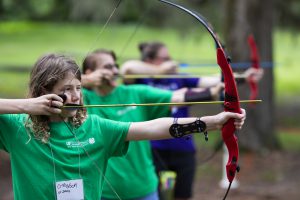
4H youth participate in archery at 4H Camp Cherry Lake. Photo taken 06-08-19.
4-H volunteers and professionals often find themselves teaching a wide variety of audiences with different needs for learning. Keeping youth of different ages and abilities engaged in project learning can be a challenge, so we are offering six specific strategies that will make this much easier- especially with practice! Last week’s post covered spacing, interleaving, and retrieval practice. This week, we will talk about elaboration, concrete examples, and dual coding. This post will also include examples of using these techniques in your work with youth.
Isn’t the 4-H Curriculum “Good Enough?”
Yes! ……And no. Some 4-H curricula have teaching strategies embedded within them. Some just have activities structured to help youth learn content. Sometimes the curriculum was not written for the age group you are working with- in that case, check out our series on applying “ages and stages” to adapt activities for youth. Learning and applying a few of these teaching strategies will make your teaching more interesting and engaging to a wider range of 4-H members. These strategies are not hard, and require a little forethought- but the return on investment can be huge. Engagement + interest = more fun for everyone!
Elaboration

Experiential learning cards are quick reference tools when using elaboration
Elaboration is simply taking the time to ask and explore how and why things work the way they do. In the 4-H world, this is part of the “reflect and apply” part of our learn-by-doing model. To be included in the 4-H Curriculum Clearinghouse (a list of approved curricula for Florida 4-H), the curricula must include opportunities for elaboration. Taking the time to dig deeper into the content this way helps youth connect the information to everyday life, and this helps the information anchor in your memory.
Before rushing to the next activity on the agenda, ask youth to reflect on what they have learned and how they might apply it to another situation. Below are some examples of questions you might ask to help youth elaborate. Another tool that is handy is the 4-H Experiential Learning Flash Cards- each card has sample questions you can use when teaching or facilitating an activity to help youth elaborate. You can order a set from the UF/IFAS Book Store or contact your local UF/IFAS Extension office.
-
- What did you learn about (life skill or activity subject matter) through this activity?
- What did you learn about yourself by doing this activity? How did others help you?
- How did you make your decisions? What steps did you take?
- What problems came up over and over? How did you handle them?
- What key points have you learned?
- Have you had similar experiences related to this project/activity?
- Where have you faced similar challenges in your life?
- How does what you learned relate to other parts of your life?
- How can you use what you learned?
- How can you apply (the life skill you practiced) in the future?
Concrete Examples
Providing specific examples can also help anchor ideas and concepts in a person’s memory. This works particularly well for younger members (juniors and intermediates) who are just starting to understand more abstract ideas. Providing more than one example helps the learner apply the information, not just remember the concept.
For example, the idea of computer coding can be an abstract concept for youth (and even some adults). One concrete example is to compare computer coding with the language we speak. You have to understand the language before you can communicate. Another example is to play “Simon Says.” In this familiar game, the players can only do exactly what “Simon” says to do otherwise they are out of the game. The same is true for computer coding. The computer will only do exactly what the programmer says to do.
Dual Coding
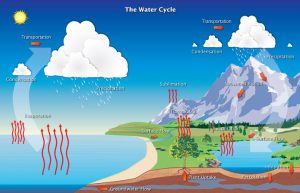
Image credit: The water cycle by NOAA National Weather Service
Dual coding is a fancy term for using words and visuals together. Research has shown that words and visuals help learners learn better than words alone or visuals alone. Some 4-H curricula do a great job including visuals- other times, you may need to search the internet or YouTube to find good visuals for more complex ideas.
For example, when teaching youth about the water cycle, a diagram of the water cycle is very helpful. Alternatively, you could show youth how to make a water cycle bracelet, where each bead represents a different part of the cycle. That way, they have a visual they can wear and refer to when exploring the water cycle.
One of the best things about 4-H is it is learner-centered. That means that youth can choose what they want to do and learn in 4-H. Your local 4-H Extension Office can help you find the best curriculum to support your youths’ learning needs, but the curriculum is only part of learning. 4-H supports learning (usually referred to as a project) through a variety of competitive and non-competitive events. The three strategies described in this post can help volunteers and 4-H professionals link learning between projects and activities. I hope this series has been helpful as you prepare to work with 4-H youth this year to “make the best better!”
References:
- Potter, S. (2021). Educational Design and Delivery – Utilization of Multiple Teaching Strategies. 4-H VKRC Fact Sheets.
- Weinstein, Y., Madan, C. R., & Sumeracki, M. A. (2018). Teaching the science of learning. Cognitive Research: Principles and Implications, 3, 2. https://cognitiveresearchjournal.springeropen.com/articles/10.1186/s41235-017-0087-y
- Weinstein, Y, Sumeracki, M & Caviglioli, O (2019) Understanding how we learn: A visual guide. Routledge, Abingdon, Oxon, UK.











